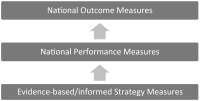A new performance measurement system for maternal and child health in the United States
- PMID: 25823557
- PMCID: PMC4428536
- DOI: 10.1007/s10995-015-1739-5
A new performance measurement system for maternal and child health in the United States
Abstract
Objective: The Title V Maternal and Child Health (MCH) Block Grant is the linchpin for US MCH services. The first national performance measures (NPMs) for MCH were instituted in 1997. Changing trends in MCH risk factors, outcomes, health services, data sources, and advances in scientific knowledge, in conjunction with budgetary constraints led the Maternal and Child Health Bureau (MCHB) to design a new performance measurement system.
Methods: A workgroup was formed to develop a new system. The following guiding principles were used: (1) Afford States more flexibility and reduce the overall reporting burden; (2) Improve accountability to better document Title V's impact; (3) Develop NPMs that encompass measures in: maternal and women's health, perinatal health, child health, children with special health care needs, adolescent health, and cross-cutting areas.
Results: A three-tiered performance measurement system was proposed with national outcome measures (NOMs), NPMs and evidence-based/informed strategy measures (ESMs). NOMs are the ultimate goals that MCHB and States are attempting to achieve. NPMs are measures, generally associated with processes or programs, shown to affect NOMs. ESMs are evidence-based or informed measures that each State Title V program develops to affect the NPMs. There are 15 NPMs from which States select eight, with at least one from each population area. MCHB will provide the data for the NOMs and NPMs, when possible.
Conclusions: The new performance measurement system increases the flexibility and reduces the reporting burden for States by allowing them to choose 8 NPMs to target, and increases accountability by having States develop actionable ESMs.
Significance: The new national performance measure framework for maternal and child health will allow States more flexibility to address their areas of greatest need, reduce their data reporting burden by having the Maternal and Child Health Bureau provide data for the National Outcome and Performance Measures, yet afford States the opportunity to develop measurable strategies to address their selected performance measures.
Figures
Similar articles
-
Title V Maternal and Child Health Services Block Grant Priority Needs and Linked Performance Measures: Current Patterns and Trends (2000-2015).Matern Child Health J. 2018 Dec;22(12):1725-1737. doi: 10.1007/s10995-018-2568-0. Matern Child Health J. 2018. PMID: 29995296
-
Strengthening the Evidence for Maternal and Child Health: Implementing the New Performance Measurement Framework for the Title V Maternal and Child Health Block Grant.Matern Child Health J. 2021 Feb;25(2):221-229. doi: 10.1007/s10995-020-03018-x. Epub 2021 Jan 4. Matern Child Health J. 2021. PMID: 33392933
-
Transformation of the title V maternal and child health services block grant.Matern Child Health J. 2015 May;19(5):927-31. doi: 10.1007/s10995-015-1736-8. Matern Child Health J. 2015. PMID: 25854797 Free PMC article.
-
Methods to measure effects of social accountability interventions in reproductive, maternal, newborn, child, and adolescent health programs: systematic review and critique.J Health Popul Nutr. 2020 Dec 7;39(1):13. doi: 10.1186/s41043-020-00220-z. J Health Popul Nutr. 2020. PMID: 33287891 Free PMC article.
-
Maternal and child health services in India with special focus on perinatal services.J Perinatol. 1997 Jan-Feb;17(1):65-9. J Perinatol. 1997. PMID: 9069069 Review.
Cited by
-
Mental health and care seeking patterns of Middle Eastern and North African immigrant children in the United States.Soc Psychiatry Psychiatr Epidemiol. 2025 Jul;60(7):1573-1580. doi: 10.1007/s00127-024-02799-8. Epub 2024 Dec 4. Soc Psychiatry Psychiatr Epidemiol. 2025. PMID: 39630271
-
Health Impact Assessment: A Missed Opportunity for MCH Professionals in Their Quest to Address the Social Determinants of Health.Matern Child Health J. 2022 Aug;26(Suppl 1):88-113. doi: 10.1007/s10995-021-03350-w. Epub 2022 Jan 24. Matern Child Health J. 2022. PMID: 35072867 Free PMC article. Review.
-
Over a Century of Leadership for Maternal and Child Health in the United States: An Updated History of the Maternal and Child Health Bureau.Matern Child Health J. 2023 Mar 25:1-15. doi: 10.1007/s10995-023-03629-0. Online ahead of print. Matern Child Health J. 2023. PMID: 36964842 Free PMC article. Review.
-
Using Behavior Over Time Graphs to Spur Systems Thinking Among Public Health Practitioners.Prev Chronic Dis. 2018 Feb 1;15:E16. doi: 10.5888/pcd15.170254. Prev Chronic Dis. 2018. PMID: 29389313 Free PMC article.
-
Title V Maternal and Child Health Services Block Grant Priority Needs and Linked Performance Measures: Current Patterns and Trends (2000-2015).Matern Child Health J. 2018 Dec;22(12):1725-1737. doi: 10.1007/s10995-018-2568-0. Matern Child Health J. 2018. PMID: 29995296
References
-
- Understanding Title V of the Social Security Act (2002). Health Resources and Services Administration, Maternal and Child Health Bureau.
-
- Omnibus Budget Reconciliation Act of 1981. Public Law 97-35, 1981.
-
- Omnibus Budget Reconciliation Act of 1989. Public Law 101-239, 1989. - PubMed
-
- Government Performance and Results Act of 1993. Public Law 103-62, 1993.
-
- Title V Maternal and Child Health Services Block Grant to the States Program: Guidance and Forms for the Title V Application/Annual Report (2012). Health Resources and Services Administration, Maternal and Child Health Bureau.
MeSH terms
LinkOut - more resources
Full Text Sources
Other Literature Sources


